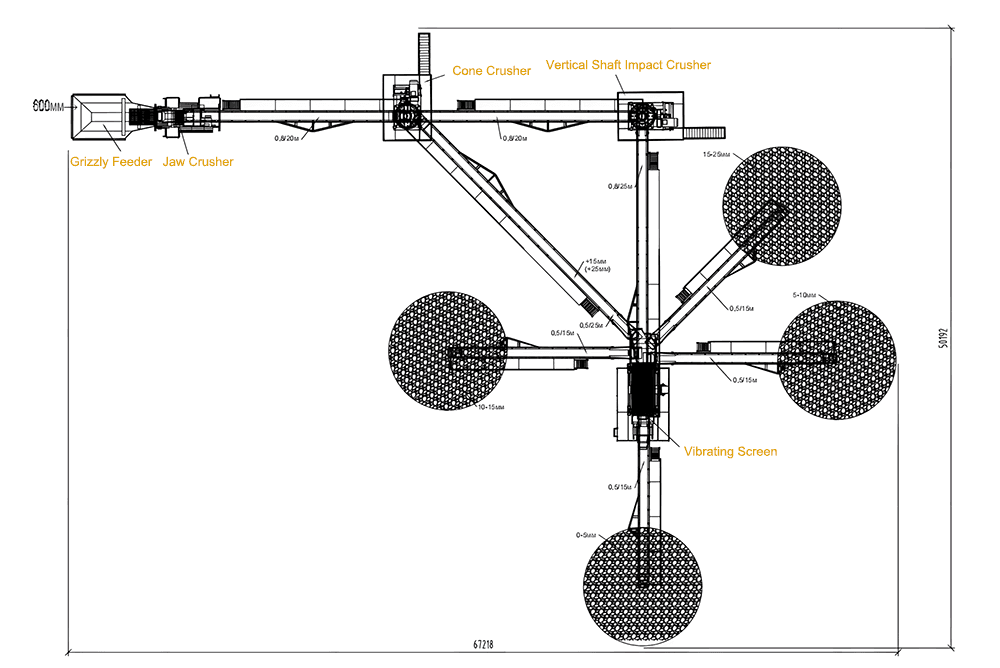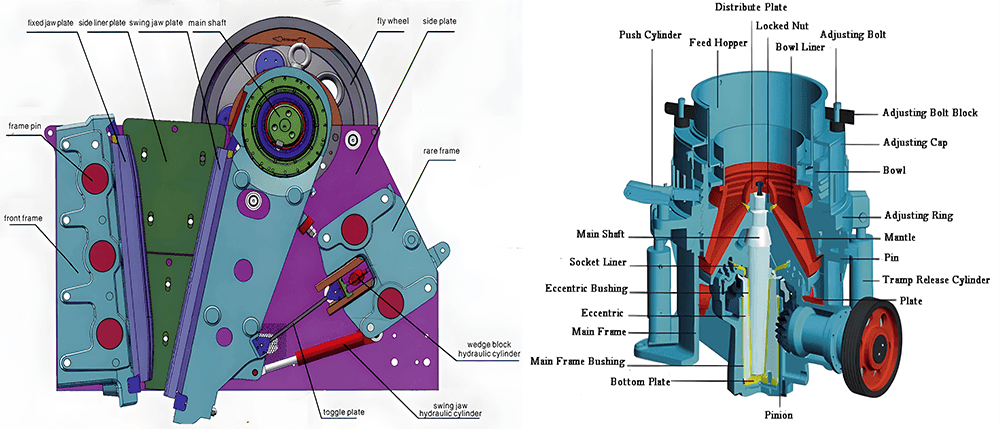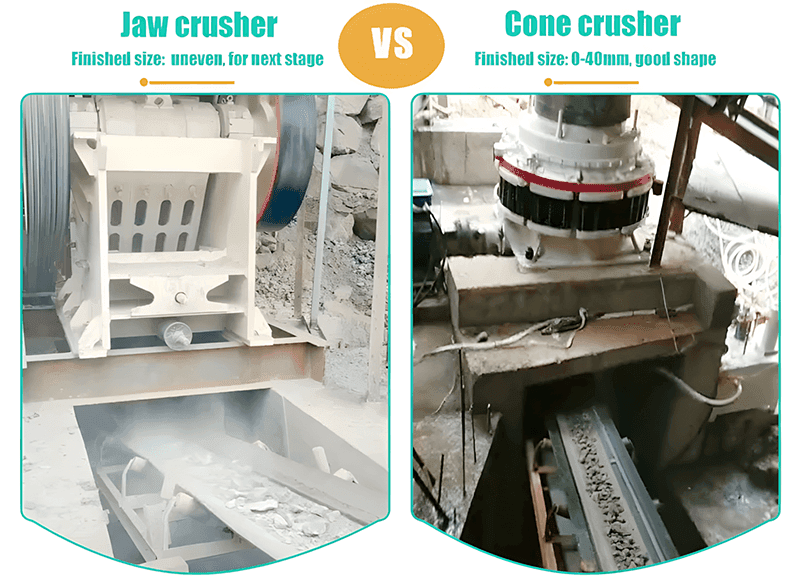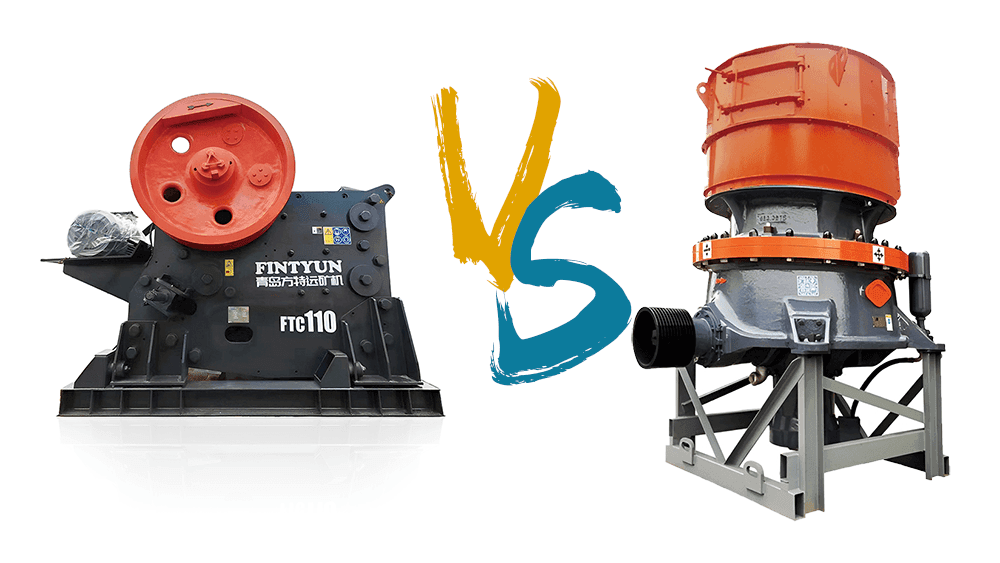Jaw crusher and cone crusher are common crushing equipment, but what sets them apart? Which one should you choose? Let’s explore their differences and benefits.
Jaw Crusher vs. Cone Crusher: A Comparison
A jaw crusher primarily handles primary crushing, breaking large stones (up to 1500mm) into smaller pieces (under 100mm) for further processing.
A cone crusher, on the other hand, crushes medium-sized stones and mainly serves as a secondary crusher. It specializes in crushing hard stones and includes a safety mechanism that activates to protect the equipment from damage.

Key Differences Between Jaw Crusher and Cone Crusher
Knowing these differences will help you choose the most suitable option.
1. Overall Structure: Jaw Crusher VS Cone Crusher
Jaw crusher:
- It has a frame, transmission mechanism, adjustment device, tensioning device, safety device, and lubrication system.
- The transmission mechanism connects the entire structure and plays a crucial role.
- It applies compressive force to crush hard stones efficiently with a high crushing ratio.
Cone crusher:
- It contains a frame, hydraulic components, head, mantle, main shaft, countershaft, feed plate, adrustment ring, socket, eccentric, pinion and gear etc.
- The crushing walls are the main wear-resistant parts.

2. Feeding Requirements Jaw Crusher VS Cone Crusher
Jaw crusher:
- Handles a wide feed size range.
- Large jaw crushers accept feed sizes over 600mm (up to 1200mm), medium ones process 300-600mm, and small ones handle under 300mm.
Cone crusher:
- Requires smaller feed sizes, typically under 450mm (varies by model).

3. Finished Product Shape
Jaw crusher:
- Ideal for primary crushing, offering high capacity but larger output sizes.
- Suitable for secondary crushing if needed.
Cone crusher:
- It handles secondary and tertiary crushing, generating smaller, uniformly shaped particles.
- Continuously crushes material until it passes through the narrow discharge opening.

4. Price Comparison
Due to its complex structure and wear-resistant parts, a cone crusher costs significantly more than a jaw crusher.
- A cone crusher stands 2-3 times higher than a jaw crusher.
- For equal output, it weighs 1-2 times heavier.
- Installation and maintenance are also more complex.
5. Example: 300 TPH Crusher Comparison
When comparing a 300-ton-per-hour setup:
- A cone crusher weighs about twice as much as a jaw crusher, increasing costs for construction and maintenance.
- Jaw crushers provide a higher crushing ratio, whereas cone crushers handle hard materials more effectively
| Model | Jaw Crusher | Cone Crusher |
|---|---|---|
| Max feed size | 630 mm | 215 mm |
| Output size | 60-150 mm | 25-60 mm |
| Capacity | 110-380 TPH | 180-360 TPH |
| Motor power | 110 kW | 160 kW |
| Weight | 29 tons | 60 tons |
Conclusion
Both jaw and cone crushers have unique advantages. Jaw crushers excel in primary crushing with high capacity, while cone crushers provide finer output for secondary and tertiary stages. Your choice depends on material hardness, desired output size, production needs, and budget. For expert guidance, consult a professional before purchasing.

Frequently Asked Questions (FAQ)
Q: Which type of crusher is best, a cone crusher or a jaw crusher?
A: Jaw crushers process stones ranging from soft limestone to hard granite, while cone crushers use a rotating mantle to achieve finer crushing.
Q: Why use a cone crusher?
A: They effectively process medium to hard rocks while consuming less energy, maintaining high reliability, and delivering a strong size reduction.
Q: How fine can a cone crusher crush?
A: Cone crushers typically process pre-sized materials (100-200mm) into smaller, well-graded output.
Q: Which crusher is best for stone?
A: The best crusher depends on material hardness, required output size, and production needs. Available choices are jaw, cone, impact, roller, hammer, VSI crushers and mobile crushing plants.
Q: What are the advantages of cone crushers?
A: Cone crushers offer high efficiency, uniform particle size, low energy consumption, and reliable performance. They excel in secondary/tertiary crushing and handle hard materials well, with built-in overload protection.
Q: What is the principle of cone crusher?
A: A cone crusher operates by squeezing materials between a rotating mantle and a stationary concave liner. The eccentric movement creates compression, breaking rocks into smaller, evenly graded particles.
Q: Are cone crushers used as primary crushers?
A: Typically no—cone crushers are mainly for secondary/tertiary crushing. However, some models (like CC400S crusher) can handle primary crushing for specific applications.
Q: What crusher is best for hard rock?
A: For hard rock (e.g., granite, basalt), jaw crushers (primary) and cone crushers (secondary) are ideal. Cone crushers’ high reduction ratio and compressive force make them especially effective.
Q: Why jaw crushers?
A: Jaw crushers are cost-effective, simple to maintain, and versatile for primary crushing. They handle large feed sizes (up to 1,500mm) and tough materials, making them a go-to for initial rock reduction.
Q: How do you maintain a cone crusher?
A: Regularly check lubrication (oil levels/filters), inspect wear parts (mantle/concaves), monitor belt tension, and clean dust/debris. Schedule downtime for liner replacements and alignment checks to prevent breakdowns.
